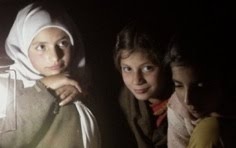 Understanding true humanity
Understanding true humanityIn Christian metaphor, the desert stands for a time of being tested – passing through ‘an aridity of spirit’, from which one can emerge renewed more strongly in one’s faith.
The desert also was literally and historically a place from which some of the most powerful spiritual teachings flowed. Moving away from religious practice that had become more and more formalized and restrictive, even as it got more popular, hundreds of Christians in the fourth century sought closeness to God in complete solitude or in small groups, deep in the deserts of Egypt, Syria and Asia Minor.
Though they lived in seclusion, they were open to visits from seekers who asked: “Speak to me a word, father, mother, that I may live…”
The life-giving words of these men and women, known with fondness and respect as “Abbas” and “Ammas”, were collected by their disciples. Mixed with these sayings are short stories about their lives; what they did was as revealing and enlightening as what they said.
The true beauty of the stories is that while they teach about intense intention, focus and discipline, they also highlight the discernment and wisdom that knows exactly when to discard these very rules and directions, and live out of a possibly contradictory perspective – but one of true ‘humanness’, which is really divine.
Once, an old monk who lived in a cave with his disciple became annoyed with the young man and drove him out. When the old man finally went to the entrance and saw the young man still patiently waiting there, he bowed before him, saying: “Come inside. Your humility and patience have overcome my narrow-mindedness. From now on, you are the father, I am the disciple; your good works have surpassed my old age.”
Silence was valued highly. Once, Theophilus, bishop of Alexandria, journeyed to Scetis and the brethren coming together said to Abba Pambo, "Say a word or two to the bishop, that his soul may be edified in this place." The old man replied, "If he is not edified by my silence, there is no hope that he will be edified by my words."
They placed hospitality and care of people so high that they were willing to open themselves to criticism and misunderstanding about this. Once, a group from Palestine travelled to Egypt and went to see one of the fathers. He offered them hospitality, and seeing him eat they asked, "Why do you not keep the fast when visitors come to see you? In Palestine the monks always keep it." He replied, "Fasting is always with me but I cannot always have you here.… What God commands is perfect love. I receive Christ in you and so must do everything possible to serve you with love. When I have sent you on your way, I can continue my rule of fasting.”
Humility, and refusing to judge others was taught through being lived: Once, a story goes, a brother in Scetis committed a fault. A council was called, to which the old and respected Abba Moses refused to go. A priest sent someone to him, saying, "Come, everyone is waiting for you". So he got up to join them, but carried on his shoulder a leaking jug filled with water. The others came out to meet him and seeing the dripping jug said, "What is this, father?" The old man said to them, "My sins run out behind me, and I do not see them, and today I am coming to judge the errors of another." Hearing this, they said no more to the brother, and forgave him.
And even though discipline was strictly adhered to, humanness always had to prevail, as one of my favorite stories teaches: Once, some monks came to see Abba Poemen and said to him, "When we see brothers dozing in the church, must we rouse them, so that they can be watchful?" He softly answered, "For my part, when I see a brother dozing, I put his head on my knees and let him rest."
May Story guide us to our true humanity.
Marguerite Theophil
Each story is a ritual, a healing event
weaving together wisdom and action, the finite and infinite,
the world of beyond and worlds in between.
The story, like a dream, is a vessel that codifies
and transmits precious information,
the innermost secrets of the heart.
~ Susan Yael Mesinai
the innermost secrets of the heart.
~ Susan Yael Mesinai


